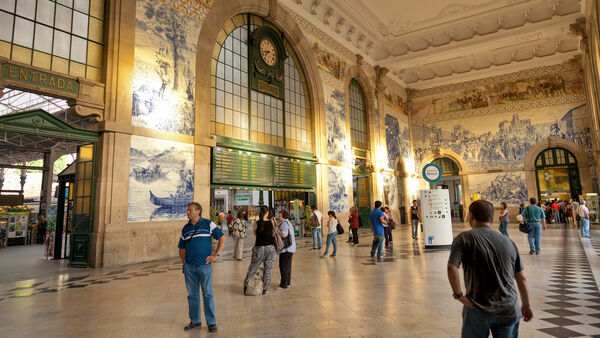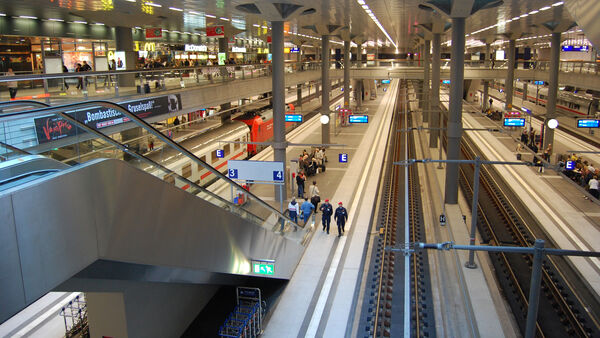European Train Stations



By Rick Steves
Great European train stations stir my wanderlust. Stepping off a train in Munich, I stand under the station's towering steel and glass rooftop and study the nearest big, blue departure screen. Every few minutes, the letters and numbers flicker as one by one cities and departure times work their way to the top and disappear just as another train glides away from its platform.
Surrounded by Germany on the move, I notice businessmen in tight neckties, giddy teenage girls, and a Karl Marx–like bum leaning on a Bierstube counter. The fast and the slow, the young and the old, we're all in this together — working our way up life's departure board.
There's plenty of romance here, but the hustle and bustle at train stations can also be confusing. Here are some tips on navigating Europe's temples of transportation.
Buying Tickets at the Station
Nearly every station has old-fashioned ticket windows staffed by human beings, usually marked by long lines; avoid them by using ticket machines, which almost always offer instructions in English.
Be aware that some ticket machines won't take American credit cards (even if they claim to), or accept them only if you key in your card's PIN. If the machines won't cooperate with your card, try cash (most machines are labeled according to the kind of payment they accept), or head for the ticket window.
If you opt for a ticket window, find the appropriate line — larger stations may have different windows for domestic, international, sleeper cars, or immediate departures. When buying tickets, you can most clearly communicate your intentions by writing what you need and showing it to the ticket agent: destination, date, time, how many people, first or second class.
It's often possible to buy tickets aboard the train, but you should expect to pay an additional fee for the convenience. Be sure to have enough cash in case the conductor can't use your American credit card. If you're buying on board, find the conductor before he finds you; otherwise, your "fee" could turn into a much heftier "fine" for traveling without a valid ticket. Be aware that on most local trains (especially commuter lines), all trains in Switzerland, and many others around Europe, you can be fined for traveling without a ticket, no matter what the circumstances are. Look for warning signs on train doors. (See my tips on buying tickets from home.)
Schedule Information
Even if you've looked up your train schedules in advance, always confirm your plans at the station. Every station has some kind of schedule information available, whether it's in printed or electronic form, or at information counters staffed by people eager (or at least able) to help you. All European timetables use the 24-hour clock.
Learning to decipher printed schedules makes life easier on Europe's rails. Posters list all trains that arrive at and depart from a particular station each day. This information is clearly shown in two separate listings: Departures are usually in yellow, and arrivals are normally in white. In some stations, you'll find free schedule booklets listing all their daily departures.
Familiarize yourself with the symbols in schedules that indicate exceptions: Crossed hammers, for instance, mean the train goes only on workdays (daily except Sundays and holidays); a cross signifies that it runs only on Sundays and holidays. Most other symbols are easy enough to guess — for instance, a little bed means the train has sleeping compartments, and crossed silverware indicates a dining car.
Many stations also have big boards that list the next several departures. These often befuddle travelers who don't realize that all over the world, the same five easy-to-identify columns are listed: destination, major stops along the way, type of train, track number, and departure time. I don't care what language they're in; without much effort you can accurately guess which column is which.
Stations may also have self-service computer terminals — many of which are also ticket machines — where you can look up schedule information. These computers are almost always multilingual and can be real time-savers. Use them to understand all your options. Many even print out a schedule tailored to your trip.
Of course, your best authority is the person at the train station information window. Uniformed employees on the platforms and on board the trains can also help.
Other Services
Besides offering travel-related services, most stations are great places to take care of your basic to-do list, with ATMs, grocery stores (usually with longer hours than you'll find in the town center), restaurants, bike-rental kiosks, and in many bigger stations, full-fledged shopping malls.
Baggage Check
Most major stations have storage lockers and/or a luggage-checking service where, for about $5 a day, you can leave your bags. People traveling light can fit two bags into one locker, cutting their storage costs in half.
Some security-conscious train stations have removed their lockers; in this case travelers can check bags at a luggage-deposit desk — often after going through an airport-type security check. You'll pay $5–15 per bag. Lock your bag and don't leave valuables inside — both for your own security and because some luggage desks won't accept unlocked bags. They may not take laptops, so be prepared to haul yours. Allow plenty of time to retrieve your bag before boarding your train. Bag-check desks come with lines, can close for lunch in smaller stations, and usually aren't open all night — confirm opening and closing times before storing your bag.
If the station doesn't offer a place to leave your bag, head to a nearby tourist-information office, hotel, or gift shop: Ask nicely, offer your most charming smile (or a small fee), and you'll likely find someone willing to keep an eye on your things for a few hours.
Internet Access
You'll find Wi-Fi hotspots at major train stations throughout most of Europe, sometimes for a fee. Wi-Fi is typically free in the first-class lounge. Finding Wi-Fi onboard is still more serendipitous than reliable, with the exception of high-speed trains on some common business routes.
Tourist Information
Many stations have a tourist information office either in the station or very nearby. Pick up a map, find out about local transit, and double-check the hours of your must-see sights.
Waiting Rooms
Most stations have comfortable waiting rooms, and travelers with fancy tickets often enjoy fancy business or VIP lounges. Before you spend hours idling in one of these rooms, take advantage of the station's services (look up schedules for the next leg of your trip, get groceries) or explore the area around the station. You may well find yourself within a short walk of something really cool. For example, if you're changing trains in Cologne, even on a tight schedule you can easily pop outside for a jaw-dropping look at its cathedral, just across the square. Waiting rooms can be decent last-ditch sleeping options (but guard your valuables).
Transit Connections
Train stations are also major transit hubs, so connections from train to bus, subway, or tram are generally no more difficult than crossing the street. If an airport is nearby, you'll find airport train or transit services (usually well marked) at the train station.
Buses connect from the station to nearby towns that lack train service. If you have a bus to catch, be quick, since many are intended for commuters and are scheduled to connect with the train and leave promptly.

